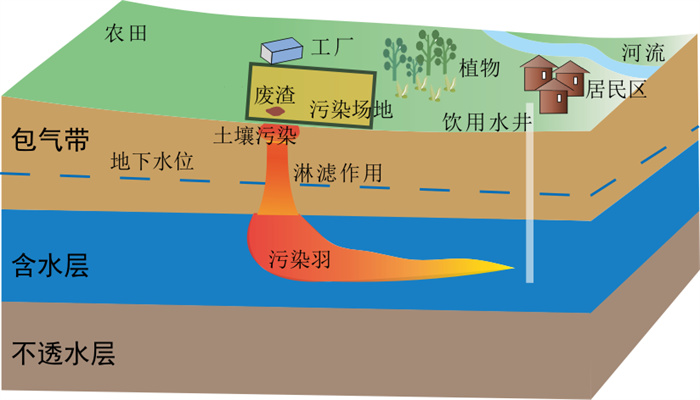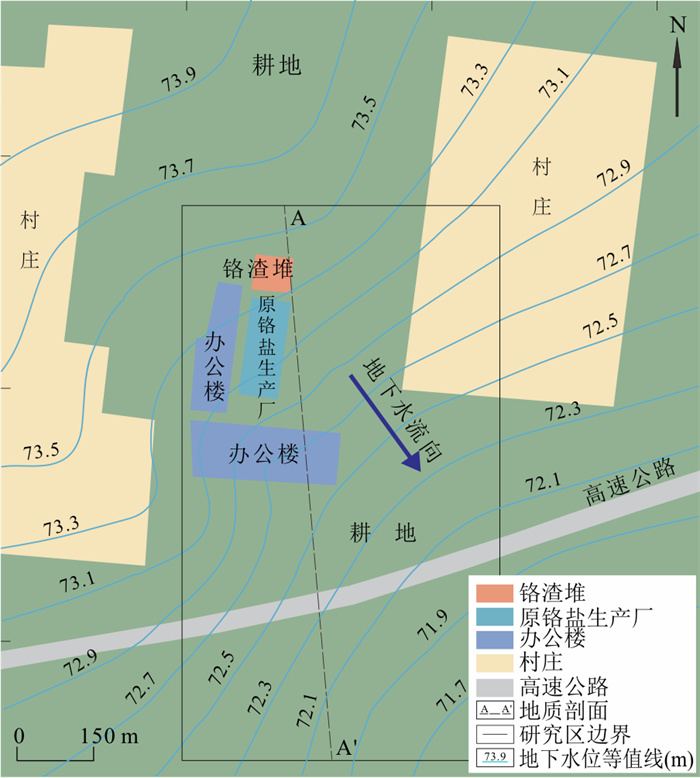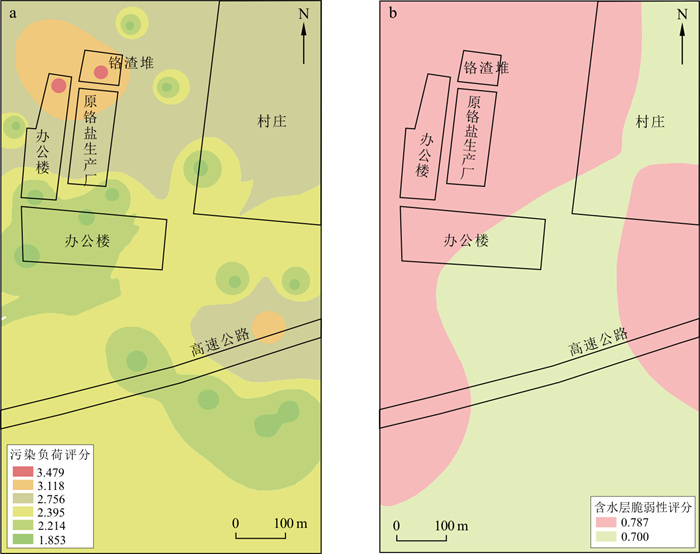Site groundwater pollution risk assessment based on the protection of sensitive receptors
-
摘要:
地下水污染风险评估是地下水污染防治的有效工具,对场地地下水污染风险评估开展研究,可以为地下水污染场地管理提供依据。我国目前的场地地下水污染风险评估忽略了场地内部污染差异性,且对受体敏感性不太关注。为此,采用场地风险评估概念模型,重点关注场地实际污染物分布特征及周边多种受体的敏感性,评价场地地下水污染风险。从污染源负荷、包气带防污性、含水层脆弱性和受体敏感性4个方面,运用层次分析法筛选了场地地下水污染风险评估的指标并确定了权重,构建了场地地下水污染风险评估指标体系,将风险划分为低、中、较高、高风险4个等级。以河南某六价铬场地为例,应用构建的风险评价体系,获取了场地的空间风险分布特征。研究结果表明,该场地整体处于中等风险水平,铬渣堆和掩埋铬渣处的东南部风险最高,污染风险主要来源于周边受体的潜在损失性及污染源负荷。敏感度分析表明各指标理论权重与有效权重几乎一致,说明所构建的场地地下水污染风险评价体系可行,可应用于其他特征污染物场地的污染风险评估。
Abstract:Groundwater pollution risk assessment is an effective tool for preventing and controlling groundwater pollution. The study on groundwater pollution risk assessment can serve as a basis for the management of groundwater contaminated sites. The present risk assessments often ignore the spatial variability of pollution within the site and the susceptibility of receptor. This paper proposes a new site groundwater pollution risk index system that can be used for pollution sites with a variety of features. The index system considers the spatial distribution of pollutant at the site and nearby receptors. Based on the four aspects of pollution load, vadose zone vulnerability, aquifer vulnerability, and receptor susceptibility, this paper conducted index screening and weight calculation using the analytical hierarchy process. A site groundwater pollution risk assessment index system was constructed, and the risk was divided into four levels: low, medium, higher, and high. Using the constructed risk index system, the spatial risk distribution of a hexavalent chromium site in Henan Province was studied. The results show that the site was at a medium risk level, with the highest risk at the chrome slag heaps and the southeastern of the buried chrome slag. The potential loss of surrounding receptors and the pollution load are the main causes of groundwater contamination risk at the site. Single parameter sensitivity analysis shows that the effective weights of each index are in line with the theoretical weights, indicating the rationality of the constructed site groundwater pollution risk assessment system, which can be applied to other sites with characteristic pollutants.
-
Key words:
- site /
- risk assessment /
- receptor susceptibility /
- pollution characteristics /
- sensitivity analysis
-
毒性等级 污染物说明 评分 分配系数/(cm3·g-1) 评分 衰减特征/d 评分 污染物超标倍数 评分 ND 无致癌证据的污染物 1 >3 2 ≤10 0 未超标 1 D 尚不能进行人类致癌分类的污染物 3 (1,3] 6 (10,20] 2 ≤5 3 C 可能的人类致癌物 5 ≤1 10 (20,30] 4 (5,10] 4 B 很可能的人类致癌物 8 (30,40] 6 (10,50] 6 A 人类致癌物 10 (40,50] 8 (50,100] 8 >50 10 >100 10 土壤类型 评分 包气带介质类型 评分 包气带垂向渗透系数/(m·d-1) 评分 地下水埋深/m 评分 非凝聚性黏土 1 承压层 1 ≤0.001 2 ≤1.5 10 腐殖土 2 粉砂、黏土 2 (0.001,0.01] 4 (1.5,4.6] 9 黏质壤土 3 层状灰岩、灰岩、层状页岩 3 (0.01,1] 6 (4.6,9.1] 7 粉质壤土 4 砂岩 4 (1,10] 8 (9.1,15.2] 5 壤土 5 含粉砂和黏土的砂砾 5 >10 10 (15.2,22.9] 3 砂质壤土 6 变质岩、火成岩 6 (22.9,30.5] 2 压实黏土 7 页岩 7 >30.5 1 泥炭土 8 砂砾岩 8 砂土 9 玄武岩 9 砾石、薄层 10 岩溶灰岩 10 含水层岩性 含水层水力传导系数/(m·d-1) 地形坡度/% 含水层厚度/m 分级 评分 分级 评分 分级 评分 分级 评分 溶岩灰岩 10 (0.04,4.1] 1 ≤2 10 ≤5 10 玄武岩 9 (4.1,12.3] 2 (2,6] 9 (5,20] 8 砂砾岩 8 (12.3,28.7] 4 (6,12] 5 (20,35] 7 块状灰岩、块状砂岩 7 (28.7,41] 6 (12,18] 3 (35,50] 5 层状砂岩、页岩、灰岩 6 (41,82] 8 >18 1 >50 1 冰碛层 5 >82 10 风化的变质岩、火成岩 4 变质岩、火成岩 3 块状页岩 2 地下水利用类型 评分 场地周边500 m内人口数量/人 评分 敏感区域距场地距离/m 评分 不使用 2 ≤100 1 >1 000 1 工业用水 4 (100,1 000] 4 (300,1 000] 4 农业灌溉用水 6 (1 000,5 000] 7 (100,300] 7 补给水源 8 >5 000 10 ≤100 10 生活用水 10 表 5 场地地下水污染风险评价指标体系及权重[35]
Table 5. Indicators for assessing groundwater pollution risk at the site and their weights
目标层 准则层 单层次权重 指标层 单层次权重 总权重 场地地下水污染风险评估 污染源负荷 0.347 9 毒性 0.200 9 0.069 9 污染物分配系数 0.200 9 0.069 9 半衰期 0.078 9 0.027 4 污染物超标倍数 0.519 3 0.180 7 包气带防污性 0.102 1 土壤类型 0.375 0.038 3 包气带岩性 0.125 0.012 8 垂向渗透系数 0.125 0.012 8 地下水埋深 0.375 0.038 3 含水层脆弱性 0.102 1 含水层岩性 0.372 5 0.038 0 水力传导系数 0.134 1 0.013 7 地形坡度 0.067 4 0.006 9 含水层厚度 0.426 1 0.043 5 受体敏感性 0.447 9 地下水利用类型 0.428 6 0.192 500 m内人口数量 0.428 6 0.192 敏感区域距场地距离 0.142 9 0.064 表 6 地下水污染风险等级
Table 6. Rating of groundwater pollution risk
等级划分 低风险 中风险 较高风险 高风险 综合指数R ≤4 (4,6] (6,8] (8,10] 表 7 研究场地风险评价各指标评分
Table 7. Scores of each indicators for the site risk assessment of site
指标层 污染场地相关数据 评分 毒性 A类 10 分配系数 <1 cm3/g 10 半衰期 不衰减 10 污染物超标倍数 0~105 1~10 土壤类型 黏质壤土 3 包气带岩性 粉土 2 垂向渗透系数 0.5~1 m/d 6 地下水埋深 2~3 m 9 含水层岩性 中砂、细砂(层状) 6 水力传导系数 5~20 m/d 4 地形坡度 0~2% 10 含水层厚度 2.16~14.78 m 8~10 地下水利用类型 农业灌溉用水 6 500 m内人口数量 100~1 000人 4 敏感区域距场地距离 农用井<100 m 10 表 8 准则层评分值
Table 8. Scores of the criterion level
准则层 评分 污染负荷 1.853~3.479 包气带防污性 0.562 含水层脆弱性 0.7~0.788 受体敏感性 2.56 表 9 单参数敏感度统计结果
Table 9. Statistical results of single parameter sensitivity
指标层 总权重 理论权重/% 排序 有效权重/% 排序 标准差 毒性 0.069 9 6.99 4 11.03 4 0.91 污染物分配系数 0.069 9 6.99 5 11.03 5 0.91 半衰期 0.027 4 2.74 11 4.32 9 0.36 污染物超标倍数 0.180 7 18.07 3 11.63 3 7.23 土壤类型 0.038 3 3.83 8 1.81 11 0.15 包气带岩性 0.012 8 1.28 12 0.40 15 0.03 垂向渗透系数 0.012 8 1.28 13 1.21 12 0.10 地下水埋深 0.038 3 3.83 9 5.44 8 0.45 含水层岩性 0.038 0 3.80 10 3.60 10 0.30 水力传导系数 0.013 7 1.37 14 0.86 14 0.07 地形坡度 0.006 9 0.69 15 1.09 13 0.09 含水层厚度 0.043 5 4.35 7 6.29 7 0.72 地下水利用类型 0.192 0 19.20 1 18.18 1 1.50 500 m内人口数量 0.192 0 19.20 2 12.12 2 1.00 敏感区域距场地距离 0.064 0 6.40 6 10.10 6 0.83 -
[1] 李笑诺, 陈卫平, 吕斯丹. 国内外污染场地风险管控技术体系与模式研究进展[J]. 土壤学报, 2022, 59(1): 38-53. https://www.cnki.com.cn/Article/CJFDTOTAL-TRXB202201004.htmLi X N, Chen W P, Lü S D. Advancement in researches on technical systems and modes for risk management and control of contaminated sites at home and aborad[J]. Acta Pedologica Sinica, 2022, 59(1): 38-53(in Chinese with English abstract). https://www.cnki.com.cn/Article/CJFDTOTAL-TRXB202201004.htm [2] Giubilato E, Zabeo A, Critto A, et al. A risk-based methodology for ranking environmental chemical stressors at the regional scale[J]. Environment International, 2014, 65: 41-53. doi: 10.1016/j.envint.2013.12.013 [3] 滕彦国, 苏洁, 翟远征, 等. 地下水污染风险评价的迭置指数法研究综述[J]. 地球科学进展, 2012, 27(10): 1140-1147. https://www.cnki.com.cn/Article/CJFDTOTAL-DXJZ201210015.htmTeng Y G, Shu J, Zhai Y Z, et al. A review on the overlay and index method for groundwater pollution risk assessment[J]. Advances in Earth Sciences, 2012, 27(10): 1140-1147(in Chinese with English abstract). https://www.cnki.com.cn/Article/CJFDTOTAL-DXJZ201210015.htm [4] Kazakis N, Voudouris K S. Groundwater vulnerability and pollution risk assessment of porous aquifers to nitrate: Modifying the drastic method using quantitative parameters[J]. Journal of Hydrology, 2015, 525: 13-25. doi: 10.1016/j.jhydrol.2015.03.035 [5] Liu F M, Yi S P, Ma H Y, et al. Risk assessment of groundwater environmental contamination: A case study of a karst site for the construction of a fossil power plant[J]. Environmental Science and Pollution Research, 2019, 26(30): 30561-30574. doi: 10.1007/s11356-017-1036-5 [6] 李翔, 汪洋, 鹿豪杰, 等. 京津冀典型区域地下水污染风险评价方法研究[J]. 环境科学研究, 2020, 33(6): 1315-1321. https://www.cnki.com.cn/Article/CJFDTOTAL-HJKX202006002.htmLi X, Wang Y, Lu H J, et al. Groundwater pollution risk assessment method in a typical area of Beijing-Tianjin-Hebei region[J]. Research of Environmental Sciences, 2020, 33(6): 1315-1321(in Chinese with English abstract). https://www.cnki.com.cn/Article/CJFDTOTAL-HJKX202006002.htm [7] 刘朋超, 武文培, 冉睿予, 等. 基于保护水环境的场地地下水风险评估模拟应用研究[J]. 土壤, 2022, 54(1): 136-144. doi: 10.3969/j.issn.1673-3908.2022.01.021Liu P C, Wu W P, Ran R Y, et al. Modelling application for contaminated land groundwater risk assessment based on prospection of water environment[J]. Soils, 2022, 54(1): 136-144(in Chinese with English abstract). doi: 10.3969/j.issn.1673-3908.2022.01.021 [8] Li F W, Zhu J Z, Deng X Y, et al. Assessment and uncertainty analysis of groundwater risk[J]. Environmental Research, 2018, 160: 140-151. doi: 10.1016/j.envres.2017.09.030 [9] 奚旭, 张新长, 孙才志, 等. 不确定性条件下的下辽河平原地下水脆弱性评价及空间分布软区划[J]. 地理科学, 2017, 37(9): 1439-1448. https://www.cnki.com.cn/Article/CJFDTOTAL-DLKX201709017.htmXi X, Zhang X C, Sun C Z, et al. Assessment and soft zoning of groundwater vulnerability in the lower reach of the Liaohe River Plain under uncertainty condition[J]. Scientia Geographica Sinica, 2017, 37(9): 1439-1448 (in Chinese with English abstract). https://www.cnki.com.cn/Article/CJFDTOTAL-DLKX201709017.htm [10] Stevenazzi S, Bonfanti M, Masetti M, et al. A versatile method for groundwater vulnerability projections in future scenarios[J]. Jounal of Environmental Management, 2017, 187: 365-374. [11] 刘海龙, 马小龙, 袁欣, 等. 基于多元回归分析的铬污染地下水风险评价方法[J]. 吉林大学学报: 地球科学版, 2016, 46(6): 1823-1829. https://www.cnki.com.cn/Article/CJFDTOTAL-CCDZ201606023.htmLiu H L, Ma X L, Yuan X, et al. Risk assessment method of chromium(Ⅵ)polluting groundwater based on multiple regression analysis[J]. Journal of Jilin University: Earth Science Edition, 2016, 46(6): 1823-1829(in Chinese with English abstract). https://www.cnki.com.cn/Article/CJFDTOTAL-CCDZ201606023.htm [12] Tartakovsky D M. Probabilistic risk analysis in subsurface hydrology[J]. Geophysical Research Letters, 2007, 34(5): L05404. http://www.xueshufan.com/publication/1999234425 [13] Yang Y, Jiang Y, Lian X, et al. Risk-based prioritization method for the classification of groundwater pollution from hazardous waste landfills[J]. Environmental Management, 2016, 58(6): 1046-1058. doi: 10.1007/s00267-016-0749-4 [14] 洪梅, 张博, 李卉, 等. 生活垃圾填埋场对地下水污染的风险评价: 以北京北天堂垃圾填埋场为例[J]. 环境污染与防治, 2011, 33(3): 88-91, 95. https://www.cnki.com.cn/Article/CJFDTOTAL-HJWR201103021.htmHong M, Zhang B, Li H, et al. Risk assessment of domestic waste landfill on groundwater pollution[J]. Environmental Pollution and Control, 2011, 33(3): 88-91, 95(in Chinese with English abstract). https://www.cnki.com.cn/Article/CJFDTOTAL-HJWR201103021.htm [15] 周鹏, 穷达卓玛, 汪晶, 等. 西藏日喀则市生活垃圾填埋场地下水污染风险评价研究[J]. 环境保护科学, 2019, 45(6): 114-118. https://www.cnki.com.cn/Article/CJFDTOTAL-HJBH201906020.htmZhou P, Qiongda Z M, Wang J, et al. Risk assessment of groundwater pollution for landfill site in Shigatse, Tibet[J]. Environmental Protection Science, 2019, 45(6): 114-118(in Chinese with English abstract). https://www.cnki.com.cn/Article/CJFDTOTAL-HJBH201906020.htm [16] 程思茜, 廖镭, 张涵. 基于迭置指数法的简易垃圾填埋场地下水污染风险研究[J]. 安全与环境工程, 2020, 27(5): 62-69. https://www.cnki.com.cn/Article/CJFDTOTAL-KTAQ202005010.htmCheng S X, Liao L, Zhang H. Groundwater pollution risk assessment of simple landfill with overlay and index method[J]. Safety and Environmental Engineering, 2020, 27(5): 62-69 (in Chinese with English abstract). https://www.cnki.com.cn/Article/CJFDTOTAL-KTAQ202005010.htm [17] 杨昱, 廉新颖, 马志飞, 等. 污染场地地下水污染风险分级技术方法研究[J]. 环境工程技术学报, 2017, 7(3): 323-331. https://www.cnki.com.cn/Article/CJFDTOTAL-HKWZ201703010.htmYang Y, Lian X Y, Ma Z F, et al. Risk ranking technology method on groundwater pollution of contaminated sites[J]. Journal of Environmental Engineering Technology, 2017, 7(3): 323-331 (in Chinese with English abstract). https://www.cnki.com.cn/Article/CJFDTOTAL-HKWZ201703010.htm [18] 薛佩佩, 文章, 梁杏. 地质统计学在含水层参数空间变异研究中的应用进展与发展趋势[J]. 地质科技通报, 2022, 41(1): 209-222. https://www.cnki.com.cn/Article/CJFDTOTAL-DZKQ202201023.htmXue P P, Wen Z, Liang X. Application and development trend of geostatistics in the research of spatial variation of aquifer parameters[J]. Bulletin of Geological Science and Technology, 2022, 41(1): 209-222(in Chinese with English abstract). https://www.cnki.com.cn/Article/CJFDTOTAL-DZKQ202201023.htm [19] 覃星铭, 马国斌, 蒋忠诚, 等. 典型石漠化峰丛洼地土壤重金属的空间分异特征及其影响因素[J]. 地质科技通报, 2022, 41(5): 283-292. doi: 10.19509/j.cnki.dzkq.2022.0189Qin X M, Ma G B, Jiang Z C, et al. Spatial variations and influencing factors analysis of heavy metals in the soil of typical rocky desertification peak cluster depression[J]. Bulletin of Geological Science and Technology, 2022, 41(5): 283-292(in Chinese with English abstract). doi: 10.19509/j.cnki.dzkq.2022.0189 [20] Li X, Wu H, Qian H. Groundwater contamination risk assessment using intrinsic vulnerability, pollution loading and groundwater value: A case study in Yinchuan Plain, China[J]. Environmental Science and Pollution Research, 2020, 27(36): 45591-45604. http://pubmed.ncbi.nlm.nih.gov/32803582/ [21] Fadlelmawla A A, Fayad M, El-gamily H, et al. A land surface zoning approach based on three-component risk criteria for groundwater quality protection[J]. Water Resources Management, 2011, 25(6): 1677-1697. http://doc.paperpass.com/foreign/rgArti20118201518.html [22] Li H, Yu X, Zhang W, et al. Risk assessment of groundwater organic pollution using hazard, intrinsic vulnerability, and groundwater value, Suzhou City in China[J]. Exposure and Health, 2018, 10(2): 99-115. http://www.onacademic.com/detail/journal_1000039923259810_2b2e.html [23] Sharif H M. Panel estimation for CO2 emissions, energy consumption, economic growth, trade openness and urbanization of newly industrialized countries[J]. Energy Policy, 2011, 39(11): 6991-6999. http://pdfs.semanticscholar.org/83ed/5692aeb41722b8c3b6aa57a0551aabf7c98c.pdf [24] Zhai Y, Jiang Y, Cao X, et al. Valuation of ecosystem damage induced by soil-groundwater pollution in an arid climate area: Framework, method and case study[J]. Environmental Research, 2022, 211: 113013. [25] 张钧帅, 汪丙国, 刘天奇. 江汉平原浅层地下水防污性能模糊综合评价与验证[J]. 地质科技通报, 2020, 39(6): 154-164. https://www.cnki.com.cn/Article/CJFDTOTAL-DZKQ202006017.htmZhang J S, Wang B G, Liu T Q. Fuzzy comprehensive evaluation and its validation for shallow groundwater vulnerability in Jianhan Plain[J]. Bullentin of Geological Scuence and Technology, 2020, 39(6): 154-164(in Chinese with English abstract). https://www.cnki.com.cn/Article/CJFDTOTAL-DZKQ202006017.htm [26] 赵鹏, 何江涛, 王曼丽, 等. 地下水污染风险评价中污染源荷载量化方法的对比分析[J]. 环境科学, 2017, 38(7): 2754-2762. https://www.cnki.com.cn/Article/CJFDTOTAL-HJKZ201707015.htmZhao P, He J T, Wang M L, et al. Comparison and analysis of the quantitative methods for pollutant sources load in groundwater contamination risk assessment[J]. Environmental Science, 2017, 38(7): 2754-2762 (in Chinese with English abstract). https://www.cnki.com.cn/Article/CJFDTOTAL-HJKZ201707015.htm [27] 贾晓青, 刘建, 罗明明, 等. 基于改进的DRASTIC模型对香溪河典型岩溶流域地下水脆弱性评价[J]. 地质科技情报, 2019, 38(4): 255-261. https://www.cnki.com.cn/Article/CJFDTOTAL-DZKQ201904027.htmJia X Q, Liu J, Luo M M, et al. Comparison and analysis of the quantitative methods for pollutant sources load in groundwater contamination risk assessment[J]. Geological Science and Technology Information, 2019, 38(4): 255-261(in Chinese with English abstract). https://www.cnki.com.cn/Article/CJFDTOTAL-DZKQ201904027.htm [28] 王俊杰, 何江涛, 陆燕, 等. 地下水污染风险评价中特征污染物量化方法探讨[J]. 环境科学, 2012, 33(3): 771-776. https://www.cnki.com.cn/Article/CJFDTOTAL-HJKZ201203015.htmWang J J, He J T, Lu Y, et al. Quantitative method of representative contaminants in groundwater pollution risk assessment[J]. Chinese Journal of Environmental Science, 2012, 33(3): 771-776(in Chinese with English abstract). https://www.cnki.com.cn/Article/CJFDTOTAL-HJKZ201203015.htm [29] 金爱芳, 李广贺, 张旭. 地下水污染风险源识别与分级方法[J]. 地球科学: 中国地质大学学报, 2012, 37(2): 247-252. https://www.cnki.com.cn/Article/CJFDTOTAL-DQKX201202008.htmJin A F, Li G H, Zhang X. The risk source indentification and classification methodology of groundwater pollution[J]. Earth Science: Journal of China Universuty of Geosciences, 2012, 37(2): 247-252(in Chinese with English abstract). https://www.cnki.com.cn/Article/CJFDTOTAL-DQKX201202008.htm [30] 张艳, 刘永, 雷波, 等. 基于多层次集对分析的退役铀尾矿库区浅层地下水污染风险评价[J]. 安全与环境学报, 2018, 18(2): 778-783. https://www.cnki.com.cn/Article/CJFDTOTAL-AQHJ201802066.htmZhang Y, Liu Y, Lei B, et al. Multilevel set-pair analysis for groundlayer surface water pollution risk in th uranium-rejected tailing reservoir[J]. Journal of Safety and Environment, 2018, 18(2): 778-783(in Chinese with English abstract). https://www.cnki.com.cn/Article/CJFDTOTAL-AQHJ201802066.htm [31] 钟佐燊. 地下水防污性能评价方法探讨[J]. 地学前缘, 2005, 12(增刊1): 3-11. https://www.cnki.com.cn/Article/CJFDTOTAL-DXQY2005S1000.htmZhong Z S. A discussion of groundwater vulnerability assessment methods[J]. Earth Science Frontiers, 2005, 12(S1): 3-11(in Chinese with English abstract). https://www.cnki.com.cn/Article/CJFDTOTAL-DXQY2005S1000.htm [32] 嵇囡囡. 基于用地类型的土壤风险评估及分级方法研究[D]. 辽宁大连: 大连理工大学, 2020.Jin N N. Research on soil risk assessment and classification method based on land use types[D]. Dalian Liaoning: Dalian Universuty of Technology, 2020(in Chinese with English abstract). [33] 郇环, 王金生. 松花江松原段沿岸浅层地下水脆弱性评价[J]. 地质科技情报, 2011, 30(5): 97-102. https://www.cnki.com.cn/Article/CJFDTOTAL-DZKQ201105017.htmXun H, Wang J S. Phreatic groundwater vulnerability assessment in Songyuan section of Songhua River[J]. Geological Science and Technology Information, 2011, 30(5): 97-102(in Chinese with English abstract). https://www.cnki.com.cn/Article/CJFDTOTAL-DZKQ201105017.htm [34] Balsara S, Jain P K, Ramesh A. An integrated approach using AHP and DEMATEL for evaluating climate change mitigation strategies of the Indian cement manufacturing industry[J]. Environmental Pollution, 2019, 252: 863-878. [35] 邓雪, 李家铭, 曾浩健, 等. 层次分析法权重计算方法分析及其应用研究[J]. 数学的实践与认识, 2012, 42(7): 93-100. https://www.cnki.com.cn/Article/CJFDTOTAL-SSJS201207013.htmDeng X, Li J M, Ceng H J, et al. Research on computation methods of AHP weight vector and its applications[J]. Mathematics in Practice and Theory, 2012, 42(7): 93-100(in Chinese with English abstract). https://www.cnki.com.cn/Article/CJFDTOTAL-SSJS201207013.htm [36] 冯俊生, 张俏晨. 土壤原位修复技术研究与应用进展[J]. 生态环境学报, 2014, 23(11): 1861-1867. https://www.cnki.com.cn/Article/CJFDTOTAL-TRYJ201411021.htmFeng J S, Zhang Q C. A review on the study on practice of soil remediation in situ[J]. Ecology and Environment Sciences, 2014, 23(11): 1861-1867(in Chinese with English abstract). https://www.cnki.com.cn/Article/CJFDTOTAL-TRYJ201411021.htm [37] 李云祯, 董荐, 刘姝媛, 等. 基于风险管控思路的土壤污染防治研究与展望[J]. 生态环境学报, 2017, 26(6): 1075-1084. https://www.cnki.com.cn/Article/CJFDTOTAL-TRYJ201706023.htmLi Y Z, Dong J, Liu S Y, et al. Prospect and research of soil pollution control based on risk management[J]. Ecology and Environment Sciences, 2017, 26(6): 1075-1084(in Chinese with English abstract). https://www.cnki.com.cn/Article/CJFDTOTAL-TRYJ201706023.htm 期刊类型引用(1)
1. 金聪,吴遵红,王薇,林松,邓小虎,程邈,谭凯. 三维井间地震侧面波传播特征及其分离研究. 地球物理学进展. 2021(04): 1531-1540 .  百度学术
百度学术其他类型引用(2)
-






 下载:
下载:




 百度学术
百度学术


